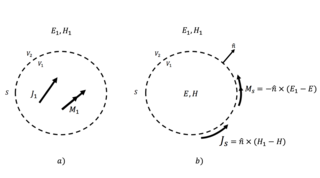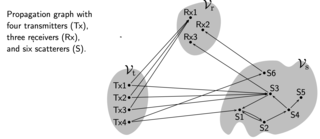
A metamaterial is a type of material engineered to have a property, typically rarely observed in naturally occurring materials, that is derived not from the properties of the base materials but from their newly designed structures. Metamaterials are usually fashioned from multiple materials, such as metals and plastics, and are usually arranged in repeating patterns, at scales that are smaller than the wavelengths of the phenomena they influence. Their precise shape, geometry, size, orientation, and arrangement give them their "smart" properties of manipulating electromagnetic, acoustic, or even seismic waves: by blocking, absorbing, enhancing, or bending waves, to achieve benefits that go beyond what is possible with conventional materials.
The boundary element method (BEM) is a numerical computational method of solving linear partial differential equations which have been formulated as integral equations, including fluid mechanics, acoustics, electromagnetics, fracture mechanics, and contact mechanics.

Finite-difference time-domain (FDTD) or Yee's method is a numerical analysis technique used for modeling computational electrodynamics. Since it is a time-domain method, FDTD solutions can cover a wide frequency range with a single simulation run, and treat nonlinear material properties in a natural way.
The electric-field integral equation is a relationship that allows the calculation of an electric field generated by an electric current distribution.

In classical electromagnetism, reciprocity refers to a variety of related theorems involving the interchange of time-harmonic electric current densities (sources) and the resulting electromagnetic fields in Maxwell's equations for time-invariant linear media under certain constraints. Reciprocity is closely related to the concept of symmetric operators from linear algebra, applied to electromagnetism.

Computational electromagnetics (CEM), computational electrodynamics or electromagnetic modeling is the process of modeling the interaction of electromagnetic fields with physical objects and the environment using computers.
Electromagnetic field solvers are specialized programs that solve Maxwell's equations directly. They form a part of the field of electronic design automation, or EDA, and are commonly used in the design of integrated circuits and printed circuit boards. They are used when a solution from first principles or the highest accuracy is required.
Characteristic modes (CM) form a set of functions which, under specific boundary conditions, diagonalizes operator relating field and induced sources. Under certain conditions, the set of the CM is unique and complete (at least theoretically) and thereby capable of describing the behavior of a studied object in full.
The multilevel fast multipole method (MLFMM) is used along with method of moments (MoM) a numerical computational method of solving linear partial differential equations which have been formulated as integral equations of large objects almost faster without loss in accuracy. This method is an alternative formulation of the technology behind the MoM and is applicable to much larger structures like radar cross-section (RCS) analysis, antenna integration on large structures, reflector antenna design, finite size antenna arrays, etc., making full-wave current-based solutions of such structures a possibility.

Weng Cho Chew is a Malaysian-American electrical engineer and applied physicist known for contributions to wave physics, especially computational electromagnetics. He is a Distinguished Professor of Electrical and Computer Engineering at Purdue University.

Generalized pencil-of-function method (GPOF), also known as matrix pencil method, is a signal processing technique for estimating a signal or extracting information with complex exponentials. Being similar to Prony and original pencil-of-function methods, it is generally preferred to those for its robustness and computational efficiency.
Roger Fuller Harrington is an American electrical engineer and professor emeritus at Syracuse University. He is best known for his contributions to computational electromagnetics with his development of method of moments (MoM). Harrington's 1968 book, Field Computation by Moment Methods, is regarded as a pivotal textbook on the subject.
In physics, the Weyl expansion, also known as the Weyl identity or angular spectrum expansion, expresses an outgoing spherical wave as a linear combination of plane waves. In a Cartesian coordinate system, it can be denoted as
Yuen Tze Lo was a Chinese American electrical engineer and academician. He was a professor emeritus at the Department of Electrical and Computer Engineering at University of Illinois at Urbana–Champaign. He is best known for his contributions to the theory and design of antennas. He is the editor of the textbook series, Antenna Handbook.

In electromagnetism, surface equivalence principle or surface equivalence theorem relates an arbitrary current distribution within an imaginary closed surface with an equivalent source on the surface. It is also known as field equivalence principle, Huygens' equivalence principle or simply as the equivalence principle. Being a more rigorous reformulation of the Huygens–Fresnel principle, it is often used to simplify the analysis of radiating structures such as antennas.
Tapan Kumar Sarkar was an Indian-American electrical engineer and Professor Emeritus at the Department of Electrical Engineering and Computer Science at Syracuse University. He was best known for his contributions to computational electromagnetics and antenna theory.

Propagation graphs are a mathematical modelling method for radio propagation channels. A propagation graph is a signal flow graph in which vertices represent transmitters, receivers or scatterers. Edges in the graph model propagation conditions between vertices. Propagation graph models were initially developed by Troels Pedersen, et al. for multipath propagation in scenarios with multiple scattering, such as indoor radio propagation. It has later been applied in many other scenarios.

The charge-based formulation of the boundary element method (BEM) is a dimensionality reduction numerical technique that is used to model quasistatic electromagnetic phenomena in highly complex conducting media with a very large number of unknowns. The charge-based BEM solves an integral equation of the potential theory written in terms of the induced surface charge density. This formulation is naturally combined with fast multipole method (FMM) acceleration, and the entire method is known as charge-based BEM-FMM. The combination of BEM and FMM is a common technique in different areas of computational electromagnetics and, in the context of bioelectromagnetism, it provides improvements over the finite element method.
Donald Robert Wilton is an American electrical engineer who is a professor emeritus at Department of Electrical and Computer Engineering at University of Houston. He is best known for his contributions to the field of computational electromagnetics.
Kenneth Kwan Hsiang Mei was a Chinese-American electrical engineer and academic, who was a professor emeritus at Department of Electrical Engineering and Computer Science at University of California, Berkeley. From 1994 until his death, he was also a professor of electrical engineering at City University of Hong Kong. He is best known for his contributions to computational electromagnetics.





























